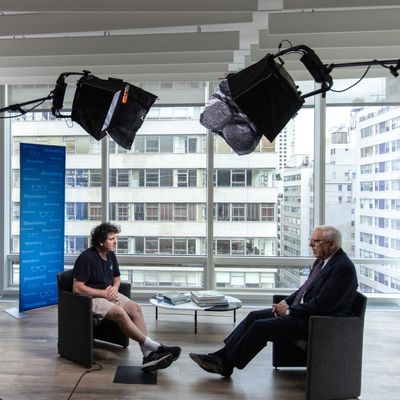
Before this month, very few people anticipated that crypto genius Sam Bankman-Fried would be exposed as a fraud playing fast and loose with customer money. But reviewing some of his interviews from the past year reveals a few clues hiding in plain sight. As the scandal unfurls further, review a few videos and inartful comments that take on a new richness after the fall.
“We don’t really know what a bitcoin is.”
This August interview with billionaire David Rubenstein is pretty boring, with the Carlyle Group co-founder asking Bankman-Fried about his unconventional wardrobe and how much he goes to the beach in the Bahamas. When Rubenstein asks if crypto is “down for the count” at the 1:30 mark, Bankman-Fried said that the 2022 collapse that helped to expose his empire “flushed out a lot of things that needed to be flushed out from the crypto space anyway.” Later, around 16:50, Bankman-Fried describes Alameda’s early pitches to venture capital firms: “Hey guys, good news, we’re a bunch of 25-year-olds, we don’t really know what a bitcoin is but we’re trading it.” From the bankruptcy statement filed on Thursday, that basically sums up how they ran the company as well.
What’s that about dipping into customer funds?
The most infamous exchange between Bankman-Fried and Bloomberg reporter Matt Levine was on a podcast episode in which the FTX founder described cryptocurrency as more or less a Ponzi scheme. But a video interview with Levine from July also betrays some interesting ideas — like Bankman-Fried describing “dipping into customer funds” as something that a company might do in distress. (To be clear, this is not normal.) Describing Alameda’s bailout of BlockFi and Voyager earlier this year, Bankman-Fried said that those crypto firms agreed to the purchase so they “can definitely pay salaries and not dip into customer funds.
Levine was incredulous. “Because otherwise they would?” he asked.
“Well, depending on the company, right?” Bankman-Fried responded.
“We try not to empty the coffers.”
After the BlockFi and Voyager bailouts, CNBC introduced Sam Bankman-Fried in an interview segment as the “J.P. Morgan of crypto” and the “Michael Jordan of crypto.” In the conversation, he explained that the goal of the purchases was to stop “contagion” from spreading in crypto — “stopping it from being the case that anyone who transitively did business with any chain of people who did business with one of the troubled assets themselves became troubled.” (Strategists are warning that could happen with FTX right now.) Bankman-Fried then claimed they had enough cash for another bailout if necessary: “We try not to empty the coffers, so to speak.”
In front of Congress, he condemned banks for their lack of transparency and “non-reported” deals.
In an appearance before Congress in December 2021, Bankman-Fried was talking about some of the risky and opaque bank actions that led to the 2008 financial crisis. “You saw a number of bilateral bespoke non-reported transactions between counterparties that got releveraged again and again and again,” he said of derivatives like the credit default swap. Less than a year later, he would admit to having a back door in the code of FTX to send billions in funds from FTX to his hedge fund Alameda. Not only were the transactions not reported, but the operation was also designed so that only Bankman-Fried and a select few would know.
“No one knew how much risk was in that system until it all fell apart,” he said of the financial crisis. Bankman-Fried then compared that to FTX, where there is “complete transparency.” Or maybe not.
He convinced millions he was a good businessman — but he’s not a good actor.
As part of Tom Brady’s brand-ambassador deal with FTX, he recorded a promo on a visit to the Bahamas in which he tells Bankman-Fried they’re going to “do some TikToks.” The apparent fraudster isn’t as excited about the prospect as the Florida divorcé:






























